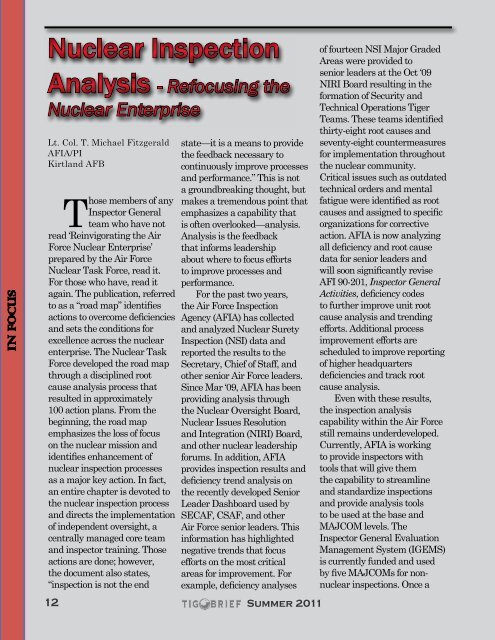tig brief - Air Force Inspection Agency
tig brief - Air Force Inspection Agency
tig brief - Air Force Inspection Agency
You also want an ePaper? Increase the reach of your titles
YUMPU automatically turns print PDFs into web optimized ePapers that Google loves.
IN FOCUS<br />
Nuclear <strong>Inspection</strong><br />
Analysis - Refocusing the<br />
Nuclear Enterprise<br />
Lt. Col. T. Michael Fitzgerald<br />
AFIA/PI<br />
Kirtland AFB<br />
Those members of any<br />
Inspector General<br />
team who have not<br />
read ‘Reinvigorating the <strong>Air</strong><br />
<strong>Force</strong> Nuclear Enterprise’<br />
prepared by the <strong>Air</strong> <strong>Force</strong><br />
Nuclear Task <strong>Force</strong>, read it.<br />
For those who have, read it<br />
again. The publication, referred<br />
to as a “road map” identifies<br />
actions to overcome deficiencies<br />
and sets the conditions for<br />
excellence across the nuclear<br />
enterprise. The Nuclear Task<br />
<strong>Force</strong> developed the road map<br />
through a disciplined root<br />
cause analysis process that<br />
resulted in approximately<br />
100 action plans. From the<br />
beginning, the road map<br />
emphasizes the loss of focus<br />
on the nuclear mission and<br />
identifies enhancement of<br />
nuclear inspection processes<br />
as a major key action. In fact,<br />
an entire chapter is devoted to<br />
the nuclear inspection process<br />
and directs the implementation<br />
of independent oversight, a<br />
centrally managed core team<br />
and inspector training. Those<br />
actions are done; however,<br />
the document also states,<br />
“inspection is not the end<br />
state—it is a means to provide<br />
the feedback necessary to<br />
continuously improve processes<br />
and performance.” This is not<br />
a groundbreaking thought, but<br />
makes a tremendous point that<br />
emphasizes a capability that<br />
is often overlooked—analysis.<br />
Analysis is the feedback<br />
that informs leadership<br />
about where to focus efforts<br />
to improve processes and<br />
performance.<br />
For the past two years,<br />
the <strong>Air</strong> <strong>Force</strong> <strong>Inspection</strong><br />
<strong>Agency</strong> (AFIA) has collected<br />
and analyzed Nuclear Surety<br />
<strong>Inspection</strong> (NSI) data and<br />
reported the results to the<br />
Secretary, Chief of Staff, and<br />
other senior <strong>Air</strong> <strong>Force</strong> leaders.<br />
Since Mar ‘09, AFIA has been<br />
providing analysis through<br />
the Nuclear Oversight Board,<br />
Nuclear Issues Resolution<br />
and Integration (NIRI) Board,<br />
and other nuclear leadership<br />
forums. In addition, AFIA<br />
provides inspection results and<br />
deficiency trend analysis on<br />
the recently developed Senior<br />
Leader Dashboard used by<br />
SECAF, CSAF, and other<br />
<strong>Air</strong> <strong>Force</strong> senior leaders. This<br />
information has highlighted<br />
negative trends that focus<br />
efforts on the most critical<br />
areas for improvement. For<br />
example, deficiency analyses<br />
12 Summer 2011<br />
of fourteen NSI Major Graded<br />
Areas were provided to<br />
senior leaders at the Oct ‘09<br />
NIRI Board resulting in the<br />
formation of Security and<br />
Technical Operations Tiger<br />
Teams. These teams identified<br />
thirty-eight root causes and<br />
seventy-eight countermeasures<br />
for implementation throughout<br />
the nuclear community.<br />
Critical issues such as outdated<br />
technical orders and mental<br />
fa<strong>tig</strong>ue were identified as root<br />
causes and assigned to specific<br />
organizations for corrective<br />
action. AFIA is now analyzing<br />
all deficiency and root cause<br />
data for senior leaders and<br />
will soon significantly revise<br />
AFI 90-201, Inspector General<br />
Activities, deficiency codes<br />
to further improve unit root<br />
cause analysis and trending<br />
efforts. Additional process<br />
improvement efforts are<br />
scheduled to improve reporting<br />
of higher headquarters<br />
deficiencies and track root<br />
cause analysis.<br />
Even with these results,<br />
the inspection analysis<br />
capability within the <strong>Air</strong> <strong>Force</strong><br />
still remains underdeveloped.<br />
Currently, AFIA is working<br />
to provide inspectors with<br />
tools that will give them<br />
the capability to streamline<br />
and standardize inspections<br />
and provide analysis tools<br />
to be used at the base and<br />
MAJCOM levels. The<br />
Inspector General Evaluation<br />
Management System (IGEMS)<br />
is currently funded and used<br />
by five MAJCOMs for nonnuclear<br />
inspections. Once a


